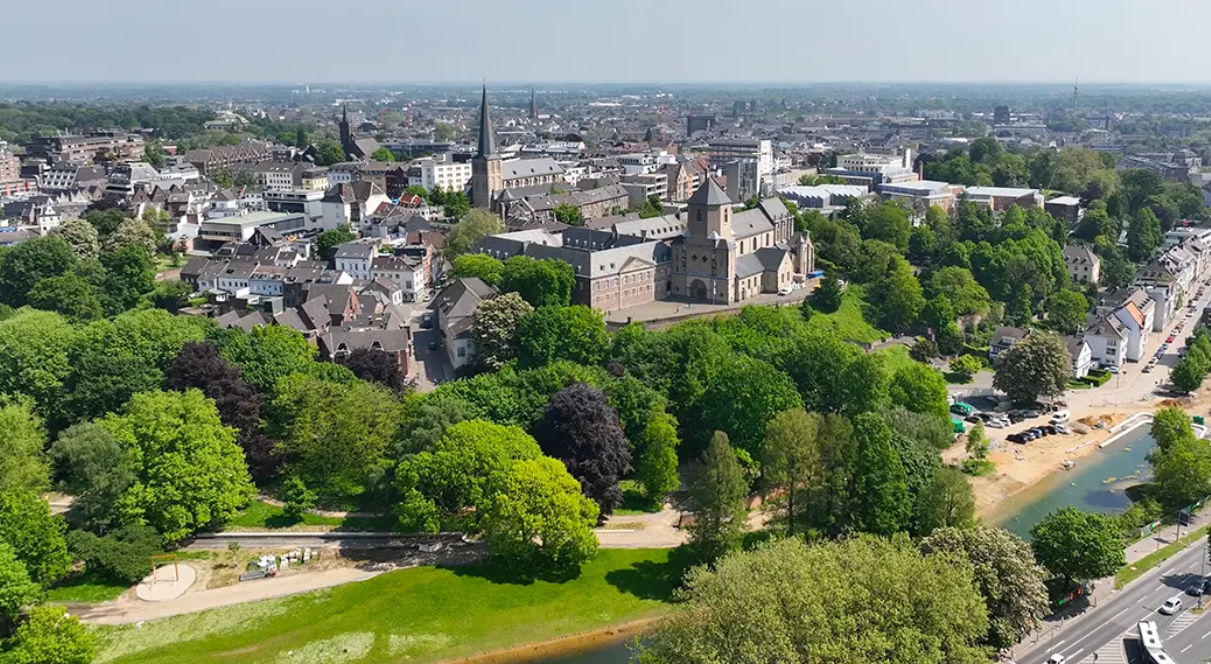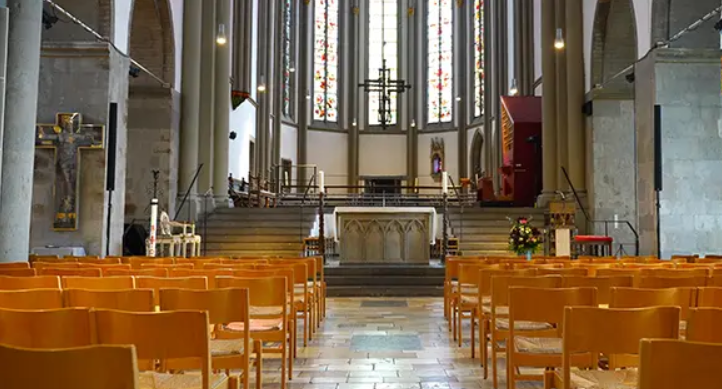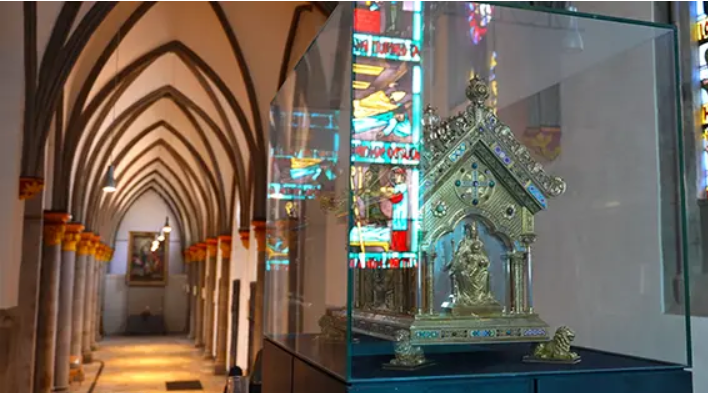A True Treasure Among Sacred Buildings
Address: St. Vitus Cathedral, Abteistraße 41, 41061 Mönchengladbach | Built: 974 | Architectural Style: Romanesque
Mönchengladbach boasts numerous churches that shape the cityscape. A true treasure among its sacred buildings is St. Vitus Cathedral. The church looks back on a 1,000-year history and served as the Benedictine abbey church from 974 to 1802. Pope Paul VI elevated the church to a “papal minor basilica” in 1974.
St. Vitus Cathedral is not just a perfect example of Romanesque architecture from a bygone era. Hidden legends and incredible facts surround the church. Those who visit St. Vitus Cathedral will immerse themselves in more than 1,000 years of history and will be rewarded with unique experiences.
Directions and location of Mönchengladbach’s landmark
The Abteiberg in Mönchengladbach is dominated by the Basilica Minor and is therefore immediately eye-catching. The Romanesque architectural style, with a choir hall built in the Gothic style, dominates the entire landscape in this part of Mönchengladbach.
The Abteiberg Municipal Museum is very close by, just a few minutes’ walk away. From there, walking along Spatzenberg Street, you will automatically reach the Abbey Garden, and through the park you can reach the church.
The area, including the church and park, is bordered on one side by Weiherstraße. Those who want to reach St. Vitus Church easily should take Abteistraße, which leads directly to the Mönchengladbach Minster and Abbey Park.
Opening Hours and Tours
St. Vitus Cathedral in Mönchengladbach is generally open every day except Friday, allowing visitors to admire the church from the inside. However, there are special opening hours for access to the church interior. The church doors are open for tours on the following days and times:
St. Vitus Cathedral Opening Hours
Monday
Closed
Tuesday
10:00 a.m. – 6:00 p.m.
Wednesday
10:00 a.m. – 6:00 p.m.
Thursday
10:00 a.m. – 6:00 p.m.
Friday
10:00 a.m. – 6:00 p.m.
Saturday and Sunday
Open for services
From November to February, St. Vitus Cathedral closes its doors at 5:00 p.m.

Admission Prices for St. Vitus Cathedral Mönchengladbach
Those who would like to see the interior of St. Vitus Cathedral need not pay any admission fees.
Guided Tours of St. Vitus Cathedral Mönchengladbach
To delve deeper into the history and uniqueness of St. Vitus Cathedral, church tours are offered for all age groups by expert guides. They know a great deal about the basilica’s 1,000-year history and are also familiar with some of the legends surrounding the church. The parish office is the first point of contact for contacting a church guide.
The church tour introduces participants to sacred art and fascinating paintings on the basilica’s stained-glass windows. The crypt, which is surrounded by stories about the devil’s legend, is also included in the tour. This provides a unique opportunity to marvel at the architectural skills of the church’s master builders.
FAQ – Frequently Asked Questions about St. Vitus Cathedral
When was St. Vitus Cathedral in Mönchengladbach built?
St. Vitus Cathedral in Mönchengladbach was built in 974, making it one of the oldest churches in the city. It has been rebuilt and expanded several times over the centuries, incorporating various architectural styles such as Romanesque, Gothic, and Baroque. Today, St. Vitus Cathedral is an important religious and architectural landmark of Mönchengladbach.
How tall is St. Vitus Cathedral?
St. Vitus Cathedral in Mönchengladbach is approximately 72 meters tall.
St. Vitus Minster Mönchengladbach – Special Features and Interesting Facts
A special landmark of Mönchengladbach is St. Vitus Minster, formerly an abbey church of the Benedictine Order. The church, elevated to a papal minor basilica by Pope Paul VI in 1974, looks back on a 1,000-year history. Therefore, there are numerous mysterious facts, peculiarities, and legends surrounding the church.
Anyone looking around St. Vitus will immediately notice a particular window in the high choir. The Bible window is a true rarity and still an original. It was not destroyed during the bombing of the Minster during World War II. The window was stored in Odenkirchen and thus survived the Second World War undamaged.
During a visit, it is worth taking a closer look at the floor of St. Vitus. The floor has a very unique history. During World War II, the cathedral was destroyed down to its walls, and the original floor was severely damaged. Printing plates donated by the Kühlen printing company were then laid as floor tiles in St. Vitus. Upon closer inspection, the letters on the printing plates can still be seen.
Another special feature of the cathedral basilica is the portable altar. It dates back to 1160 and is the oldest relic in the church. Upon closer inspection, the special goldsmith’s work is immediately noticeable. The portable altar was formerly used for holding masses outside the church. There are only five examples of this type left in the world.
The oldest room of St. Vitus is the crypt, built in 1100. It was constructed during the construction of the second church. It is not only the oldest room in the church, but also appears repeatedly in legends and sagas. The devil’s tale is said to have taken place there.
According to legend, during the Cold War, soldiers sat together in the crypt, drinking and gambling for money, where the sarcophagus of Saint Adelbertus is located. Suddenly, a dark figure appeared in the crypt to join in the game. From that point on, the soldiers lost every game. The unknown man suggested playing for the soldiers’ souls and won this game as well.
When it came time to claim the prize, the church bells of St. Vitus began to ring. The unknown man then struck the gravestone with his fist, creating two cracks that can still be seen today. He then escaped through the window behind the sarcophagus, which could no longer be closed. The cracks and stains from the red wine are still visible on the gravestone today.

Historical Facts and History of St. Vitus Minster
Finds discovered during excavations show that, between 974 and 1000 AD, there was already a monastery church on the site where St. Vitus Minster stands today. The former monastery church had a hall-like, elongated space. To the east, there appears to have been a small choir area and, on the western side, a three-part vestibule, which included a courtyard.
In the 11th century, a west tower was built on the abbey church. Unfortunately, its design is unknown. Around 1100, the church appears to have been redesigned. However, only the choir and the crypt were built. A few years later, the church was expanded, with two chapels and two side aisles being added.
Even today, the church’s massive westwork reveals the original planning. The church’s architect most likely intended to connect the three-aisled nave with the west tower. This required the construction of a flat ceiling. The nave of St. Vitus, as it still stands today, was designed between 1228 and 1239.
The two side aisles, which were intended to lead into a crossing, were the first to be built. However, the construction of the central nave had to be postponed. This was finally built in the 15th century. The three-apexes choir, which was to be modeled on Cologne churches, also caused problems. The planned crossing can still be recognized today by its massive clustered pillars.
The idea of building a new choir arose between 1256 and 1277. Ultimately, a long choir was built not in the Romanesque but in the Gothic style. Gerhard, the first master builder of Cologne Cathedral, was responsible for the planning and implementation of the long choir of St. Vitus.
After the consecration of the church by Albertus Magnus, several changes were made to the interior of the church. Baroque elements found their way into the church. The tower was given a Baroque dome and lantern.
For a long time, no one cared about the preservation and maintenance of the building until a citizens’ initiative took over St. Vitus Cathedral. Between 1857 and 1873, the association raised the necessary funds to restore the cathedral. The Cologne Cathedral master builder, Vincenz Statz, was commissioned to do the work.
The Cologne Cathedral master builder had the baroque dome removed, the tower raised by one story, and an octagonal copper roof placed on the tower. Towards the end of World War I, the copper roof was removed again to be used to make munitions.
St. Vitus Cathedral was completely destroyed, except for its outer walls, by air raids during World War II. Once again, a citizens’ initiative worked to save the church. The Cathedral Association was founded in 1947. With the support of numerous citizens, the Diocese of Aachen, and the state of North Rhine-Westphalia, the church was rebuilt and has been shining in new splendor since the late 1950s.

Sights and attractions in the immediate vicinity of St. Vitus Cathedral in Mönchengladbach
After a tour or guided tour of St. Vitus Cathedral, a stroll through the surrounding area offers many sights and attractions.
The Abteiberg Museum, which exhibits modern art, is located directly next to the cathedral basilica.
A visit to the museum also includes a visit to the sculpture garden.
Anyone walking along Kriechelstraße will automatically come across a special building. It is located opposite the bridge that leads to the Abteiberg Museum. The exterior facade is painted gold, which is why it is called the Golden House.
If you haven’t had enough of churches yet, you should also visit the City Church Alter Markt, Kirchplatz 14. The City Church Alter Markt is an interesting building for architecture and building art lovers, as it showcases the Late Gothic architectural style in a unique way.
Another old building near St. Vitus Cathedral is the old armory at Weiherstraße 2 to 6. The building houses the Mönchengladbach Carnival Museum, which houses an impressive exhibition.
Numerous fountains can also be found in the immediate vicinity of St. Vitus Cathedral. The Vitus Fountain, located at Rathausstraße 11 A on Edmund-Erlemann-Platz, is adorned with a bronze statue of St. Vitus.
Cafés and Restaurants Near St. Vitus Cathedral Mönchengladbach
A long walk through Mönchengladbach and a visit to St. Vitus Cathedral will make you hungry and thirsty. You’ll also long to rest a bit and reflect on your experiences. The best place to do this is in the cafés and restaurants near St. Vitus Cathedral.
Moshi Bar
Those who enjoy sushi, Asian, and Japanese food will find a nice selection of specialties on the menu at Moshi Bar, Krichelstraße 22. Guests are also offered a varied selection of drinks. A beautiful, appealing ambiance invites you to linger and enjoy.
Address: Moshi Bar, Krichelstraße 22, 41061 Mönchengladbach
St. Vieth, Alter Markt 6, is a quaint brewery that serves delicious food. The menu features good brewery cuisine. Traditional Rhineland specialties as well as European and Central European dishes are offered. Guests can also enjoy a fine selection of drinks.
Address: St. Vieth, Alter Markt 6, 41061 Mönchengladbach
Benitos – Mexican Restaurant and Cocktail Bar
Mexican, Latin American, American, and Spanish delicacies can be found on the menu at Benitos – Mexican Restaurant and Cocktail Bar, Alter Markt 55. The selection of delicious dishes is extensive. There’s also a great selection of cocktails. Those who visit Benitos during happy hour can even save money on cocktails.
Address: Benitos – Mexican Restaurant and Cocktail Bar, Alter Markt 55, 41061 Mönchengladbach